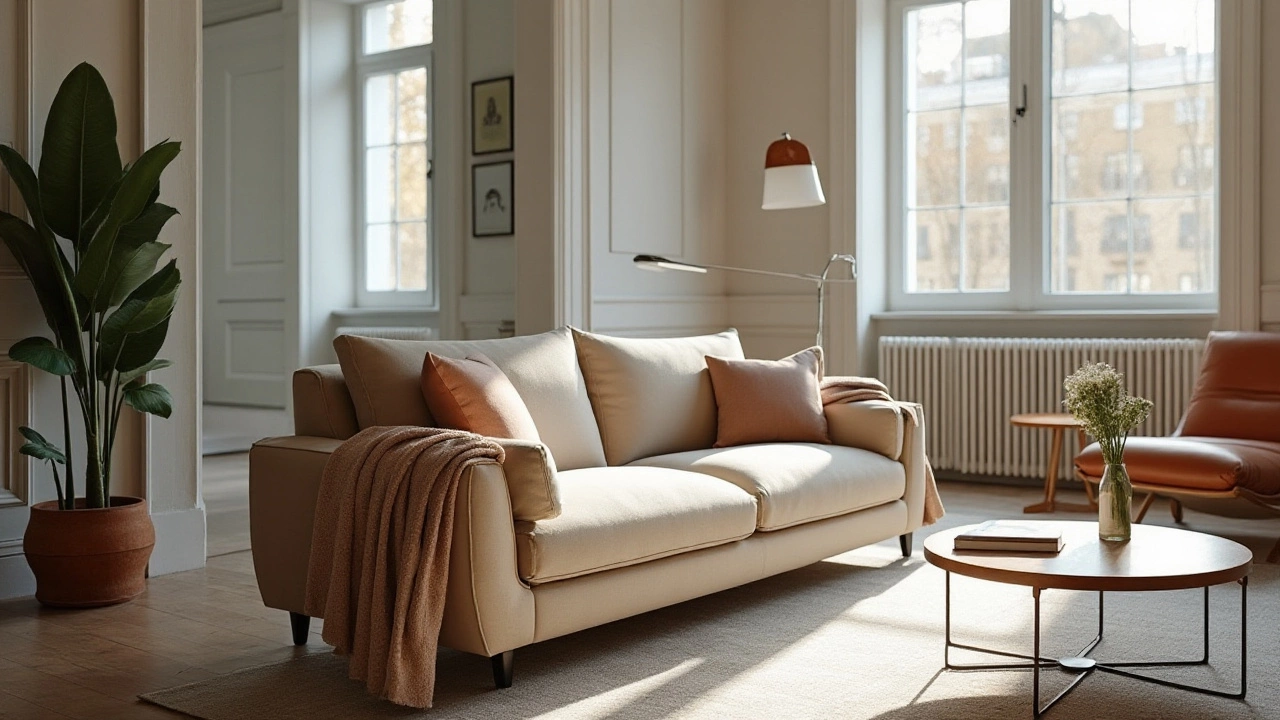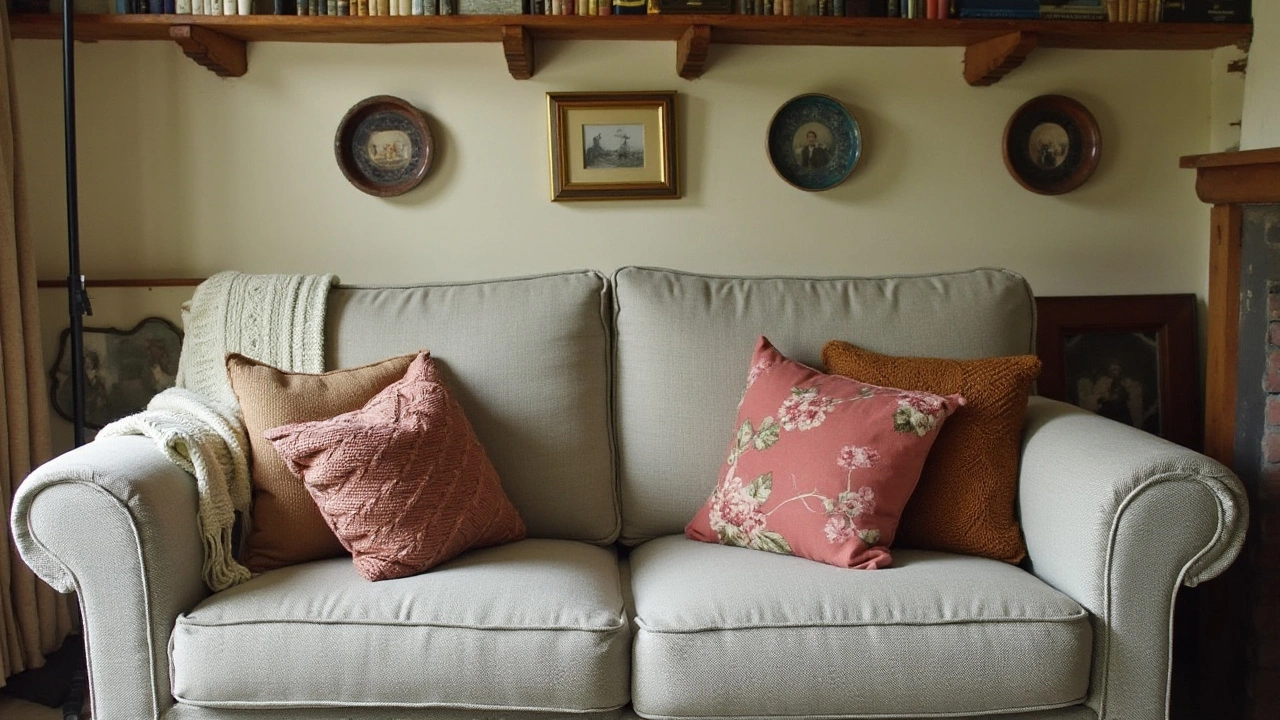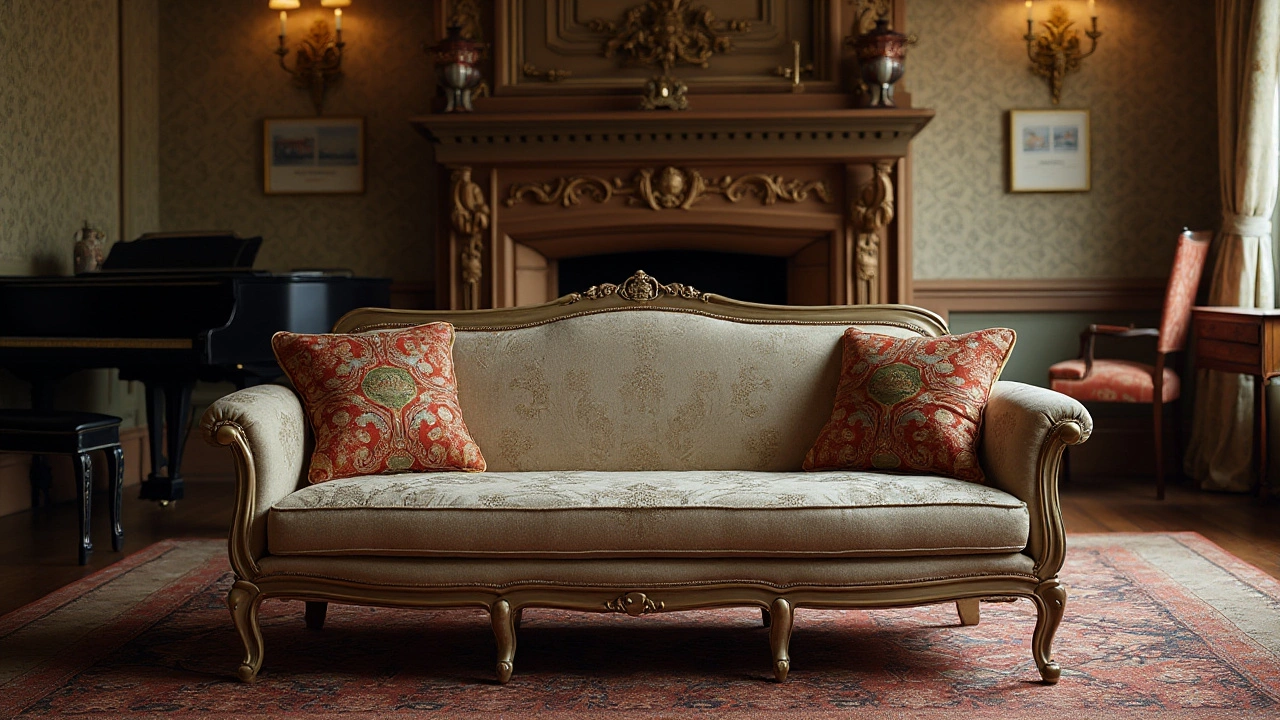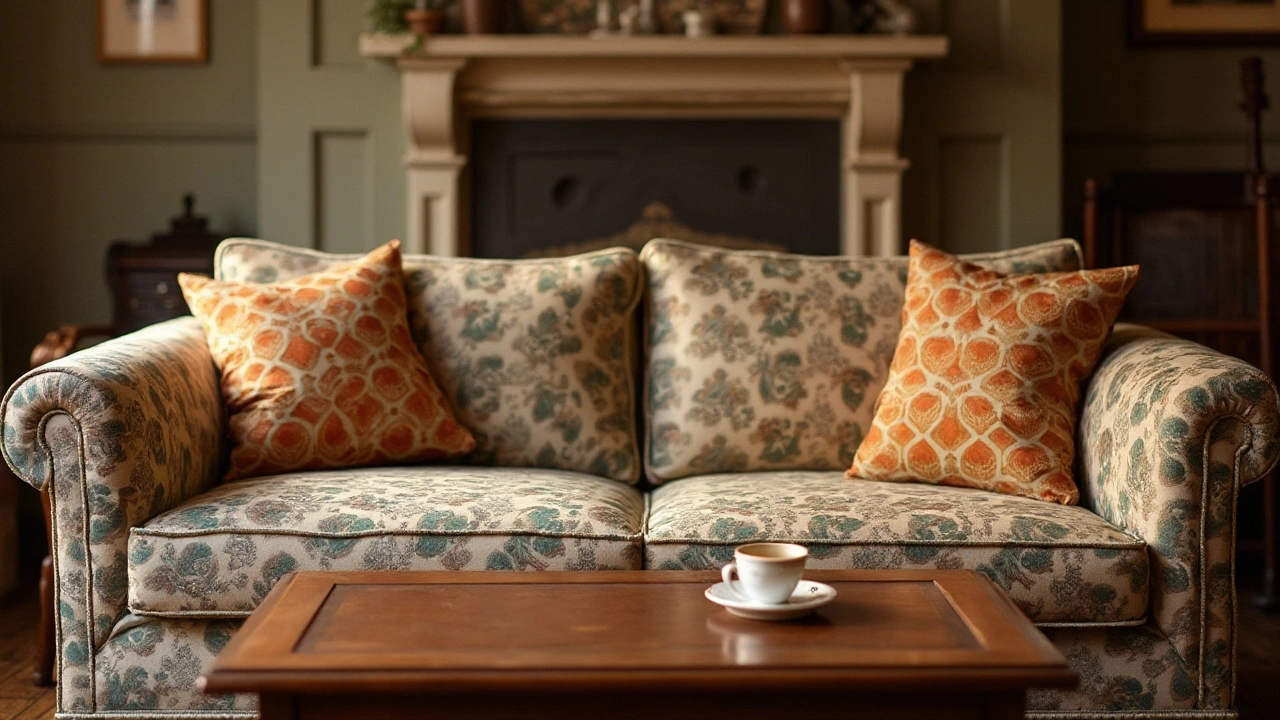In the world of living room furniture, the three-seater sofa is a staple. Its presence is almost obligatory in homes desiring both space and style. Yet, a peculiar trend prevails: despite having room for three, many of these sofas possess only two cushions. At first glance, this might seem a minor detail, but there's a story to uncover here.
Delving into furniture design, you’ll find that choice often boils down to striking a balance between function and form. The decision to incorporate two cushions rather than three is not just an oversight or a compromise. Various factors come into play, including aesthetics, comfort, and historical precedents. It’s a design choice that has evolved over time, shaped by a changing understanding of style and functionality.
This article embarks on a journey to explain this common design element. We'll explore how different aspects such as cushion size, sofa frame structure, and fabric choice contribute to this trend. Additionally, tips on selecting the right sofa and maintaining its condition will be shared, ensuring your furniture not only looks great but also endures years of use.
- The Evolution of Sofa Design
- Practicality Versus Aesthetics
- Impact on Comfort and Style
- Tips for Choosing and Maintaining Sofa Cushions
The Evolution of Sofa Design
The sofa has come a long way, transforming from a symbol of luxury into a ubiquitous element of home decor. Tracing back to ancient civilizations, the concept of seating has always been associated with comfort and status. During the Egyptian era, stone seats adorned with cushions were found in the homes of the elite. Fast forward to the 18th century, and you will witness the emergence of the first true sofas in Europe. These were grand affairs, often found in the salons of the French aristocracy, designed with intricate patterns and lavish upholstery. The designs were meant not only for seating but also as a demonstration of wealth and taste.
As industrialization took hold in the 19th century, mass production began to influence furniture design. A revolution unfolded, making sofas more accessible to the burgeoning middle class. This era introduced a variety of styles, each with its own unique cushioning techniques. The Chesterfield sofa, known for its deep button tufting and plush seating, became popular in the Victorian era. Meanwhile, the Art Deco movement in the early 20th century emphasized sleek, geometric shapes, altering the proportion and arrangement of cushions. This shift laid the foundation for the now-common three-seater sofa with two cushions, blending modern aesthetics with practicality.
The mid-20th century, marked by a wave of innovation in design, saw the chair-based living room morph into a sofa-centric space. Designers like Charles and Ray Eames championed the idea of multifunctional furniture, placing emphasis on both form and function. This era fostered the need for streamlined designs, leading to the practical choice of two larger seat cushions. Not only did this simplify production, it also afforded greater flexibility in styling and maintenance.
"Embrace simplicity and functionality," advised Charles Eames, encapsulating the era's design ethos. Their sentiment echoed across homes, influencing how furniture was conceptualized and the way it fit into the evolving dynamics of the family living space.
While the reason for two cushions on a three-seater sofa could be boiled down to economics or simplicity, the truth is more profound. Modern sofa cushions cater to varying lifestyles, offering versatility in both spatial dynamics and decor. The practicality of having fewer but broader cushions appeals to busy individuals who prefer low-maintenance furniture. Additionally, the design complements open-plan living spaces, seamlessly integrating with other elements. Designers today aim to meet the evolving needs of consumers, without compromising on style and comfort. Thus, the evolution of sofa design narrates a tale of change, reflecting broader cultural and economic shifts through the lens of a household staple.

Practicality Versus Aesthetics
When it comes to choosing the right furniture for your living room, practicality and aesthetics often find themselves at odds, especially in the realm of sofa design. A three-seater sofa with just two cushions is a testament to this delicate balance. On one hand, practicality demands furniture be not only functional but comfortable for daily use. Three symmetrical cushions might seem like the sensible option to suit three people comfortably, but reality paints a different picture. Sofa cushions need to align with the frame in a way that supports sitting without causing discomfort from awkward seams or uneven surfaces. Sitting across two cushions, many argue, offers a more streamlined and stable platform. This subtlety contributes not only to comfort but also to durability, as a lesser number of seams typically translate to a decreased likelihood of wear and tear over time.
Aesthetics, on the other hand, dictates that furniture should complement the style of a home, marrying functionality with form. As peculiar as it may sound, two larger cushions can provide a cleaner, more sophisticated appearance. They mimic the sleek lines and minimalism sought after in modern interior design trends, offering a unified, uninterrupted appearance that three separate cushions often disrupt. A well-designed sofa is not merely about seating but is a focal point that ties together the room's elements. Furniture design experts have noted that reducing visual clutter through fewer, larger cushions can make a room appear more spacious and orderly. According to renowned interior designer Valerie Fortune, "Less is often more when it comes to creating a harmonious living space; allowing the couch to breathe visually can transform a room's entire dynamic."
Yet, the decision does not only stumble upon couch space or style preferences but also turns to historical influences. Historically, sofa designs like the Chesterfield and the Victorian settee, paved the way for contemporary interpretations. These classic pieces were meticulously crafted with aesthetics in mind, often leaning towards fewer yet lavishly upholstered cushions. This historic precedent has insinuated itself into modern perceptions of a home interior's elegance, prompting contemporary designs to echo these ideals of grandeur and seamless beauty. Today, when buyers encounter a two-cushion sofa, they're witnessing the evolution of centuries of design philosophy that champions simplicity alongside opulence in subtle measures.
Ultimately, the appeal of the two-cushion design lies in the versatility it offers—an equilibrium between the demands of practicality and the allures of aesthetics. It’s both an homage to enduring design traditions and an acknowledgement of modern preferences, proving that good design truly is timeless. While some might miss the obvious third cushion, others embrace the clarity and comfort it brings. As with any element of home decor, what matters most is what works for your lifestyle and complements your personal taste. After all, a sofa is where life's moments unfold, one cushion at a time.

Impact on Comfort and Style
When it comes to sofa cushions, how they affect comfort and style cannot be overstated. Two cushion designs on three-seater sofas aren't merely aesthetic choices; they're often grounded in the quest for optimal comfort. Comfort has a lot to do with surface division. When a three-seater sofa has two cushions, each cushion is typically longer and allows for more uniform weight distribution. This design change ensures that when two people occupy the sofa, there's less likelihood of gaps forming between the cushions, thereby providing a more seamless sitting experience. People tend to enjoy this continuity, as it feels more like sitting on a single, larger seat rather than multiple smaller ones. Additionally, fewer cushions mean fewer gaps where comfort might be compromised, enhancing the overall sitting experience.
Moreover, the stylistic impact of cushion configuration plays a pivotal role in interior design. The minimalist look of two cushions on a three-seater sofa can create a sleek, contemporary vibe, particularly appealing in modern homes. This design choice can make rooms feel open and less cluttered. The pattern, color, and texture of each cushion get greater room to breathe and be noticed. Some designers argue that fewer, larger cushions encourage better use of patterns and textures, creating a bolder statement. According to Elle Decor, many designers

Tips for Choosing and Maintaining Sofa Cushions
Picking the right cushions for your sofa cushions can make a world of difference in both style and comfort. It might seem like a straightforward decision at first, but there’s an art to selecting cushions that will bring out the best in your home’s decor. The first thing to consider is the size of the cushions. While larger cushions can offer more support and coverage, they might not always suit every sofa design, especially when trying to maintain an evenly proportioned look for a three-seater. Consider the existing furniture layout and ensure that the cushions do not overwhelm the space.
Another critical factor is the material of the cushions. Fabrics such as cotton and linen are known for their breathability and natural feel, making them ideal for homes in warmer climates. In contrast, suede and leather might add a touch of elegance, but they require more upkeep and might not be as comfortable during hotter months. When choosing cushion materials, keep in mind who will be using the sofa. If you have children or pets, opting for fabrics that are more durable and stain-resistant would be a practical choice. Pay attention to the cushion filling as well—foam offers firm support, while feather or down alternatives provide a plush experience.
Colors and patterns should not be overlooked either. While neutral and solid colors might offer versatility, experimenting with bold patterns can inject life and personality into your living room. However, striking the right balance is key, as overdoing it might clash with other elements in the space. To create a cohesive look, you can draw inspiration from a piece of artwork or a beloved rug. Color swatches are helpful tools for visualizing how the cushions will mesh with your furniture before making a purchase.
Maintaining furniture design, especially your cushions, involves regular cleaning and care, which can ensure their longevity. Vacuuming cushions weekly is a simple way to remove dust and debris and prevent them from embedding themselves into the fabric. Spot cleaning spills immediately is crucial, as neglect can lead to stains that are harder to remove. Check the cushions for any specific care instructions provided by the manufacturer, particularly when it comes to machine washing versus dry cleaning. For those interested in minimizing their environmental footprint, using natural and non-toxic cleaners can be an excellent choice.
Rotating your cushions periodically and flipping them over can help maintain their shape and prevent wear patterns. This habit is particularly helpful for cushions with a blend of foam and feathers. In certain cases, investing in additional cushion covers might be wise—this allows for easy swapping and washing, maintaining the overall aesthetic of the living room. Never underestimate the power of a fresh, clean set of cushions to enliven a space.

